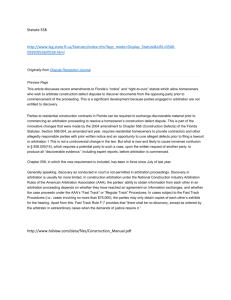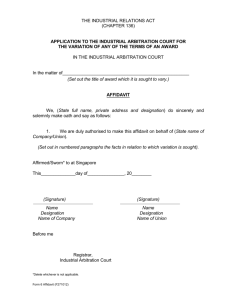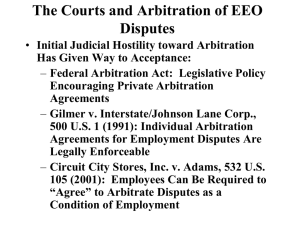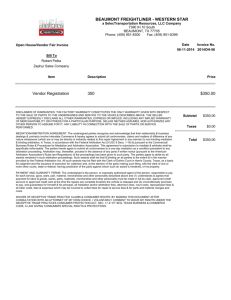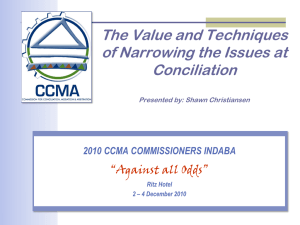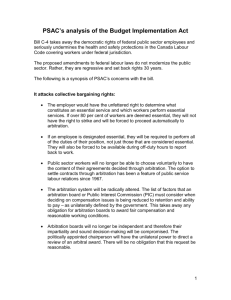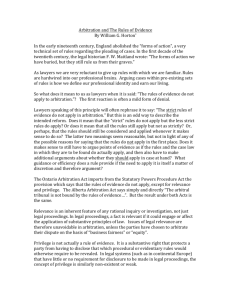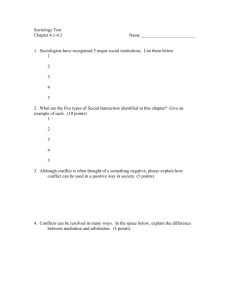Recent Developments In Mandatory Dispute Resolution Agreements
advertisement
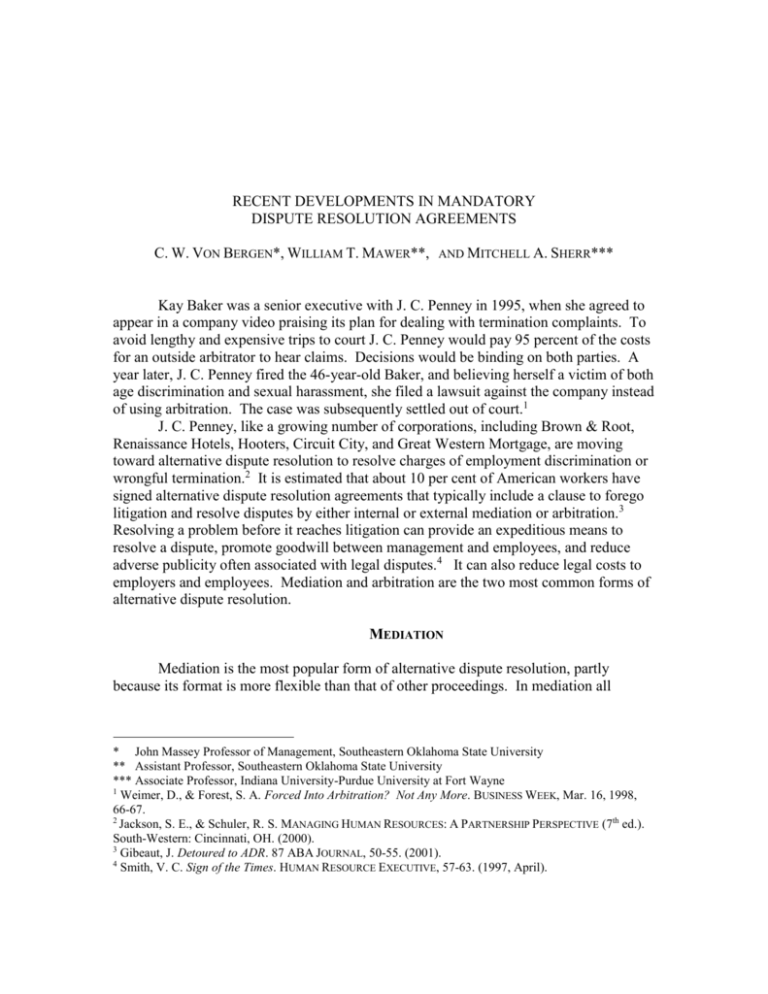
RECENT DEVELOPMENTS IN MANDATORY DISPUTE RESOLUTION AGREEMENTS C. W. VON BERGEN*, WILLIAM T. MAWER**, AND MITCHELL A. SHERR*** Kay Baker was a senior executive with J. C. Penney in 1995, when she agreed to appear in a company video praising its plan for dealing with termination complaints. To avoid lengthy and expensive trips to court J. C. Penney would pay 95 percent of the costs for an outside arbitrator to hear claims. Decisions would be binding on both parties. A year later, J. C. Penney fired the 46-year-old Baker, and believing herself a victim of both age discrimination and sexual harassment, she filed a lawsuit against the company instead of using arbitration. The case was subsequently settled out of court.1 J. C. Penney, like a growing number of corporations, including Brown & Root, Renaissance Hotels, Hooters, Circuit City, and Great Western Mortgage, are moving toward alternative dispute resolution to resolve charges of employment discrimination or wrongful termination.2 It is estimated that about 10 per cent of American workers have signed alternative dispute resolution agreements that typically include a clause to forego litigation and resolve disputes by either internal or external mediation or arbitration.3 Resolving a problem before it reaches litigation can provide an expeditious means to resolve a dispute, promote goodwill between management and employees, and reduce adverse publicity often associated with legal disputes.4 It can also reduce legal costs to employers and employees. Mediation and arbitration are the two most common forms of alternative dispute resolution. MEDIATION Mediation is the most popular form of alternative dispute resolution, partly because its format is more flexible than that of other proceedings. In mediation all * John Massey Professor of Management, Southeastern Oklahoma State University ** Assistant Professor, Southeastern Oklahoma State University *** Associate Professor, Indiana University-Purdue University at Fort Wayne 1 Weimer, D., & Forest, S. A. Forced Into Arbitration? Not Any More. BUSINESS WEEK, Mar. 16, 1998, 66-67. 2 Jackson, S. E., & Schuler, R. S. MANAGING HUMAN RESOURCES: A PARTNERSHIP PERSPECTIVE (7th ed.). South-Western: Cincinnati, OH. (2000). 3 Gibeaut, J. Detoured to ADR. 87 ABA JOURNAL, 50-55. (2001). 4 Smith, V. C. Sign of the Times. HUMAN RESOURCE EXECUTIVE, 57-63. (1997, April). 38/Vol. 13/Southern Law Journal concerned participants appear before a neutral third-party—a mediator—who helps the parties try to resolve the dispute through facilitated dialogue, flexibility, and compromise.5 The mediator cannot “force” the parties into an agreement. Use of mediation for business disputes fits the trend in many state and federal jurisdictions because judges are increasingly requiring litigants in civil disputes to submit their issues to mediation in an effort to resolve some or all of the issues prior to trial.6 Firms using mediation report success in reaching settlements in a variety of commercial litigation in three fourths of all cases.7 The trend on the part of firms, however, is toward the adoption of arbitration, particularly mandatory arbitration.8 ARBITRATION Arbitration has skyrocketed in use in civil disputes and has addressed a wide range of topics including: franchise agreements,9 investor-brokerage firm contracts,10 and pregnancy discrimination.11 Many states have adopted arbitration procedures to be used by courts during pending litigation (e.g., medical malpractice, insurance contracts, general liability insurance claims and any other claim before the court the judge wants to send to arbitration). Although conducted under relaxed rules of evidence, arbitration is an adversarial process in which the litigants control the selection and presentation of evidence and, therefore, should be perceived as no less fair than court proceedings.12 Currently, the American Arbitration Association (the primary professional arbitration organization) is administering programs at 500 companies with more than 5 million employees.13 Compared to mediation, arbitration is more formal, yet not so much so that court rules must be strictly followed. Judges must present their decisions in a formal manner, but arbitrators can provide either an oral or a written decision depending on the arbitration rules adopted and are not strictly bound by previous cases in rendering their decisions. Many employers have begun asking employees when hired to sign contracts stating that they will accept arbitration as a means to settle potential employment discrimination claims. Arbitration may be binding or non-binding. Binding arbitration requires the parties to agree (contractually) to the decision of the arbitrator prior to the decision. Nonbinding arbitration requires the parties to agree after the decision is rendered. More often, however, employees are asked to agree to binding arbitration. In these cases, the arbitrator’s decision is final, subject to a very limited right of appeal. Binding arbitration 5 Phillips, G. F. What Your Client Needs to Know about ADR. 55 DISPUTE RESOLUTION JOURNAL, 64-68. (2000). 6 Bloomberg, M. Staying Out of the Courtroom. 34 ACROSS THE BOARD, 36-37. (1997). 7 Phillips, supra note 5, at 66. 8 Bass, S. L. What the Courts Say about Mandatory Arbitration. 54 DISPUTE RESOLUTION JOURNAL, 24-31. (1999). 9 Garber v. Sir Speedy, Incorporated, 930 F. Supp. 267, aff’d. 91 F.3d 137 (5 th Cir. 1996). 10 Arent v. Shearson/American Express, Incorporated, 633 F. Supp. 770 (DC Mass, 1985). 11 Metz v. Merrill Lynch, Pierce, Fenner & Smith, Incorporated, 39 F.3d 1482 (10 th Cir. 1994). 12 Lind, E. A., & Tyler, T. R. THE SOCIAL PSYCHOLOGY OF PROCEDURAL JUSTICE. New York: Plenum. (1988). 13 Silbergeld, A. F., & Simon, H. J. The Enforceability of Predispute Agreements to Arbitrate. EMPLOYMENT RELATIONS TODAY, 105-109. (2001, Winter). Fall 2003/Recent Developments/39 has been called mandatory dispute resolution because it is a relatively new approach to resolving disputes. It is controversial. MANDATORY DISPUTE RESOLUTION Mandatory dispute resolution (also called mandatory arbitration, mandatory predispute resolution agreement, employer-promulgated arbitration, or compulsory arbitration) is surprisingly simple: make the lawsuit-for-arbitration trade-off a condition of employment. If prospective employees do not waive their right to sue, then they likely will not get the job. During the course of the last decade, there has been a dramatic rise in the number of compulsory arbitration clauses imposed by private sector employers as a condition of initial employment or continued employment.14 This trend was encouraged by the Supreme Court that found that language authorizing the use of arbitration in employment agreements does not eliminate the substantive rights afforded by the Civil Rights Act of 1964; it only provides for their resolution in an arbitral, rather than a judicial context.15 Likewise, Congress supported arbitration when in 1991 it amended the Civil Rights Act of 1964 to encourage the use of dispute resolution for resolving employment discrimination claims based on race, color, religion, national origin and gender.16 An example of a mandatory dispute resolution agreement is provided in Appendix A. Supporters of mandatory arbitration claim that the process is just as fair as a jury trial and has the added benefits of being resolved quickly and with lower costs.17 Gary Mathiason of Littler Mendelson, a labor-law firm that represents management, insists that “arbitration is the only way to get justice out of this clogged-up system.”18 Opponents argue that imposing mandatory arbitration as a condition of employment is inherently unfair because employers normally draft the specific provisions and, as repeat players, have a better understanding of the process and the opportunity to develop a relationship with arbiters.19 For example, employers in mandatory arbitration hearings will present their cases through attorneys or trained human resource representatives, while employees frequently present their own cases. Another difficulty with mandatory arbitration, foes indicate, is that organizations can set their own rules. Hooters of America, for instance, has set up an arbitration system that includes three arbitrators from a company provided list that decides the issue. Additionally, Hooters has contractually limited damages at one year’s compensation—an amount below the levels established by the Civil Rights Act of 14 Dundas, M. J., Lynch, P., George, B. C., & Hallas, J. E. (2000). Insuring fairness and equity in employment arbitration agreements. Paper presented at the Southwest Federation of Administrative Disciplines, Southern Academy of Legal Studies in Business. San Antonio, Texas, March 15-18. 15 Mitsubishi Motors Corporation v. Soler Chrysler-Plymouth, Incorporated, 473 U.S. (1985) 16 Civil Rights Reform Act of 1991, 42 U.S.C. §§ 1981 et seq., 1991 17 Kinnecome, D. M. Where procedure meets substance: Are Arbitral Procedures a Method of Weakening the Substantive Protections Afforded by Employment Rights Statutes? 79 BOSTON UNIVERSITY LAW REVIEW, 745-777. (1999). 18 Kaufman, L., & Underwood, A. Sign or Hit the Street. NEWSWEEK, Jun. 30, 1997, 48-49. 19 Cole, S. R. A Funny Thing Happened on the Way to the (Alternative) Forum: Reexamining Alexander by Gardner-Denver in the Wake of Gilmer v. Interstate/Johnson Lane Corporation. 3 BRIGHAM YOUNG UNIVERSITY LAW REVIEW,591-629. (1997). 40/Vol. 13/Southern Law Journal 1991. Such a one-sided process is not unique. A survey of 36 companies found that approximately 10 percent disallowed outside counsel for employees, about 15 percent gave employers the sole right to choose arbitrators, and one third did not provide for discovery (the ability to request and receive relevant information from the opposing party).20 Appendix B summarizes arguments for and against mandatory arbitration practices. Federal Arbitration Act Arbitration, however, has not always been popular. Its legal recognition began in 1925 when Congress passed the Federal Arbitration Act (FAA) as a response to judicial enmity to using the practice to settle commercial disputes. The objective of the FAA is not to resolve disputes in the quickest manner possible but to insure that commercial arbitration agreements are enforced,21 to make them as enforceable as other contracts, and to make arbitration procedures speedy and not subject to delay and obstruction in courts.22 Supreme Court Justice Harry Blackmun wrote in Mitsubishi Motors Corporation v. Soler Chrysler-Plymouth, Incorporated23 that “By agreeing to arbitrate a statutory claim, a party does not forgo the substantive rights afforded by the statute; it only submits to their resolution in an arbitral, rather than a judicial, forum. It trades the procedures and opportunity for review of the Courtroom for the simplicity, informality and the expedition of arbitration” (p. 628). Section 2 of the FAA declares Congressional policy favoring arbitration agreements, notwithstanding any state policies to the contrary;24 i.e., arbitration is permitted unless there is a federal rule that clearly expresses the intent not to arbitrate an issue. If the issue of arbitration is in doubt, it is to be resolved in favor of arbitration25 . Gilmer v. Interstate/Johnson Lane Corporation served as a catalyst for greater employer interest in mandatory arbitration.26 In Gilmer, the U.S. Supreme Court found an employment agreement stipulating the use of arbitration procedures binding on a newly hired employee, even though the employee was seeking protection against age discrimination guaranteed under federal statutes. Gilmer, a stockbroker, was fired at age 62 and sued his firm for age discrimination. Like all such brokers, however, he had waived the right to take his employer to court in lieu of compulsory arbitration, in order to be licensed with the New York Stock Exchange. Gilmer did not claim that he was coerced into signing the document or that he did not understand its significance, just that it was inherently illegal to compel arbitration of a discrimination case. The Supreme Court surprised many by upholding the agreement based on the FAA, which states that 20 Bickner, M. L., Ver Ploeg, K. T., & Feigenbaum, C. Developments in Employment Arbitration. 52 DISPUTE RESOLUTION JOURNAL 8-22 (1997). 21 First Options v. Kaplan, 515 U.S. 938 (1995). 22 Prima Paint Corporation v. Flood & Conklin Manufacturing Company, 388 U.S. 395 (1967) 23 Mitsubishi Motors Corporation v. Soler Chrysler-Plymouth, Incorporated, 473 U. S. 614 (1985) 24 Federal Arbitration Act, 9 U.S.C. §§ 1 et seq. (1925). 25 Stateside Machinery Company v. Alperin, 591 F.2d 234 (3rd Cir. 1979). 26 Gilmer v. Interstate/Johnson Lane Corporation, 500 US 20, 24, 111 S. Ct. 1647, 1651 (1991) Fall 2003/Recent Developments/41 parties to a commercial contract can waive Court rights in exchange for binding arbitration.27 In theory, the ruling applied only to stockbrokers. But in practice, it cleared a path through the discrimination-law thicket for employers in every industry and since 1991 many lower-court decisions have greatly expanded the boundaries of the decision. For example, Michele Peacock joined Great Western Mortgage's Livingston, N.J., office in September 1994. After four months on the job, she claimed her male boss was harassing her so blatantly that she had to quit. The final outrage was when she arrived at an out-of-town business conference and allegedly found herself booked into a hotel room with him. It was found that as part of her job application she had agreed to mandatory arbitration. Unlike Gilmer, however, Peacock says she did not understand what she was signing. The Court was unmoved by her argument and thus binding arbitration was supported.28 Circuit City Stores, Incorporated v. Adams In March 2001, the U.S. Supreme Court again reinforced an employer’s right to require mandatory arbitration of its workers. The Supreme Court in Circuit City Stores, Incorporated v. Adams29 held in a 5 to 4 decision that employment agreements containing compulsory arbitration provisions are enforceable under federal law. The Court found that employers have a reliable alternative to courtroom litigation as a means to redress employee complaints. The decision gave broad protections to arbitration agreements and provided employers with good reasons to consider instituting mandatory arbitration programs. In this case, the plaintiff Saint Clair Adams worked as a sales counselor at a Circuit City store in Santa Rosa, California. When he was hired, Circuit City required Adams to sign a pre-employment contract that contained a statement whereby he agreed to settle any federal, state, or local statutory claim exclusively by final and binding arbitration. Two years after he was hired, Adams filed a civil complaint in state court against Circuit City alleging discrimination under California’s Fair Employment and Housing Act and other claims on tort theories based on California laws. Circuit City filed an action in federal court to stop the state court action and to compel arbitration under the FAA. The federal court ordered Adams to arbitration and enjoined the state court action. On appeal, the Ninth Circuit Court of Appeals reversed the lower court, finding that the FAA did not apply to employment contracts. This decision conflicted with every other 27 Stateside Machinery Company v. Alperin, 591 F.2d 234 (3 rd Cir. 1979). Great Western Mortgage Corporation v. Peacock, 110 F.3d 222 (3rd Cir. 1997). 29 Circuit City Stores, Inc. v. Adams. 532 US 105, 121 S Ct 1302, 149 L Ed 2d 234 (2001) 28 42/Vol. 13/Southern Law Journal court of appeals which addressed the issue.30 Circuit City appealed the decision to the Supreme Court, which reversed the Ninth Circuit. In the appeal to the Supreme Court, Adams raised the issue that the FAA was not appropriate due to the exemption coverage under provisions of the Act. The Supreme Court, however, ruled that the FAA applies to all employment contracts, except those specifically exempted by the statute.31 Since Adams was not involved in transportation, the Court ruled that the FAA applied and the arbitration agreement he entered was valid and enforceable. In short, this majority decision allows employers to establish arbitration programs as the sole means for employees to resolve employment issues. Various amici curiae (“friends of the court”) briefs were filed with the Court, including attorney generals from 22 states. The briefs argued that the Court’s interpretation of the Section 1 exclusionary provision of the FAA would pre-empt those state employment laws that restrict or limit the ability of employees and employers to enter into arbitration agreements. The Court had considered this issue in a prior case, Southland Corporation v. Keating32, and held that Congress intended the FAA to apply in state courts and to preempt state anti-arbitration laws. The Supreme Court was unwilling to revisit the issue. The Circuit City decision appears to enhance the enforceability of mandatory arbitration agreements between employers and their employees. Indeed, after Circuit City, the number of companies with arbitration agreements in their employment contracts grew from around 400 to about 700.33 The Court decision further enforced the FAA’s statutes permitting preemption of state laws aimed at limiting or restricting arbitration agreements. Equal Employment Opportunity Commission v. Waffle House, Incorporated Clarity with respect to mandatory dispute resolution seemed to be forming but then another Supreme Court ruling appeared to throw the issue of mandatory dispute resolution into a state of uncertainty. On January 15, 2002, the Supreme Court decided in Equal Employment Opportunity Commission v. Waffle House, Incorporated34 that a federal agency can file lawsuits involving employees who have signed away their rights to sue their companies. The issue before the Court was whether the EEOC was bound by a mandatory arbitration clause, signed by an employee, in seeking the remedies available to the EEOC. The 6-3 decision reinforced the power of the EEOC and limited the power of businesses to keep workplace disputes out of the courts. 30 Dickenstein v. duPont, 443 F.2d 783, 785 (1 st Cir. 1971).; Erving v. Virginia Squires Basketball Club, 468 F.2d 1064, 1069 (2nd Cir. 1972).; Tenney Engineering, Incorporated v. United Electrical & Machine Workers of America, 207 F.2d 450 (3rd Cir. 1953); O’Neil v. Hilton Head Hospital, 115 F.3d 272, 274 (5 th Cir. 1997); Rojas v. TK Communications, Incorporated, 87 F.3d 354, 358 (7 th Cir. 1997); Pryner v. Tractor Supply Company, 109 F.3d 354, 358 (7th Cir. 1997); Williams v. Logicon, Incorporated, 143 F.3d 73, 575-576 (10th Cir. 1998); Cole v. Burns International Security Services, 105 F.3d 1465, 1470-1472 (DC Cir. 1997) 31 Federal Arbitration Act, 9 U.S.C. §§ 1 et seq. (1925). 32 Southland Corporation v. Keating, 465 U.S. 1 (1984). 33 Lane, C. High Court Backs EEOC Suits in Bias Cases. WASHINGTON POST, Jan. 16, 2002, at A01. 34 Equal Employment Opportunity Commission v. Waffle House, Incorporated, 122 S. Ct. 745 (2002), 2002 U.S. LEXIS 489 Fall 2003/Recent Developments/43 The case arose from the situation of Eric Baker, a short-order cook at a Waffle House restaurant in West Columbia, S. C. Baker suffered from seizures as the result of an earlier automobile accident and experienced a seizure August 10, 1994, 16 days after being hired. Waffle House fired Baker for what it claimed was his own safety, as well as the good of the restaurant. When Baker was hired, he signed an agreement saying that any disputes with Waffle House would be settled through arbitration. After he was fired, he did not begin arbitration proceedings, but instead filed a complaint with the EEOC contending that his dismissal violated the Americans with Disabilities Act of 199035 and that Waffle House did not make reasonable accommodations for him. It should be noted that the state human rights commission also investigated Baker’s claim and found no basis for a suit.36 The employment agreement read in part: “The parties agree that any dispute of claim concerning Applicant’s employment with Waffle House, Inc., or any subsidiary or Franchisee of Waffle House, Inc., or the terms, conditions or benefits of such employment, including whether such dispute or claim is arbitrable, will be settled by binding arbitration. The arbitration proceedings shall be conducted under the Commercial Arbitration Rules of the American Arbitration Association in effect at the time a demand for arbitration is made. A decision and award of the arbitrator made under the said rules shall be exclusive, final and binding on both parities, their heirs, executors, administrators, successors and assigns. The costs and expenses of the arbitration shall be borne evenly by the parties”.37 The EEOC has the authority to evaluate the strength of the public interest and to determine whether public resources should be committed to the recovery of victimspecific relief. The FAA does not mention enforcement by public agencies; it ensures the enforceability of private agreements to arbitrate, but otherwise does not purport to place any restriction on a nonparty’s choice of a judicial forum.38 The Court has ruled that valid arbitration agreements “will not preclude the EEOC from bringing actions seeking class-wide and equitable relief.”39 The question before the Court in this case was what power a government agency has to seek remedies for workers covered by binding arbitration and whether the agency can in some circumstances do for employees what they will not, or cannot, do for themselves. Does an agreement between an employer and an employee to arbitrate employment-related disputes bar the EEOC from pursuing such actions as back pay, reinstatement, and damages? In the majority opinion, Justice Stevens wrote, “In fact, the EEOC takes the position that it may pursue a claim on the employee’s behalf even after the employee has disavowed any desire to seek relief. The statute (Title VII) clearly makes the EEOC the master of its own case and confers on the agency the authority to evaluate the strength of 35 Americans With Disabilities Act, 29 U.S.C. §§ 621 et seq. (1990). Id at 34. 37 Id at 34. 38 Federal Arbitration Act, 9 U.S.C. §§ 1 et seq. (1925). 39 Gilmer v. Interstate/Johnson Lane Corporation, 500 U.S. 20 (1991). 36 44/Vol. 13/Southern Law Journal the public interest at stake.”40 The Court ruled that the EEOC retains its full right to seek victim-specific relief—compensation and punitive damages, back pay, and an order of reinstatement—just as if the employee had never signed the employment contract. The EEOC has the exclusive authority to determine whether a lawsuit should be filed, in what court the lawsuit should be filed, and the type of remedies that the government is seeking.41 Justice Clarence Thomas, Chair of the EEOC prior to being appointed to the Supreme Court, wrote a strong dissenting opinion. Justice Thomas stated that the EEOC obtained a victim-specific remedy in Court on behalf of an employee who agreed to arbitrate discrimination claims against his employer “conflicts with both the Federal Arbitration Act…and the basic principle that the EEOC must take a victim of discrimination as it finds him.”42 Justice Thomas added that the majority ruling “eviscerates Baker’s arbitration agreement with Waffle House and liberates Baker from the consequences of his agreement”.43 Finally, Justice Thomas added that the majority decision places those employers using arbitration at a serious disadvantage and that “their employees will be allowed two bites at the apple—one in arbitration and one in litigation conducted by the EEOC—and will be able to benefit from the more favorable of the two rulings.”44 Circuit City v. Adams and EEOC v. Waffle House: A Contradiction More Apparent Than Real? These two decisions underscore the often-conflicting principles in the treatment of mandatory arbitration on employment disputes by the courts. On the one hand, the courts encourage the use of arbitration and alternative dispute resolution mechanism as a matter of public policy, as reflected in the Circuit City45 case. On the other hand, some courts and legal commentators have cautioned that mandatory arbitration may erode employees’ statutory rights or the authority of agencies, like the EEOC, to enforce those rights. The ruling of Waffle House clearly endorses an independent role by the EEOC in carrying out its statutory responsibility to seek relief through the courts, even in situations where employees themselves would not be able to do so. In 1972, Congress amended Title VII of the Civil Rights Act to give the EEOC the power to enforce provisions of the Act.46 In 1991, Congress again amended Title VII to allow recovery of compensatory and punitive damages by a “complaining party.” The amendment means both private plaintiffs and the EEOC can seek the recovery.47 Interestingly, the EEOC rules and regulations provide alternate dispute resolution in resolving complaints both in the initial filing stage and after the agency has completed the investigation.48 A troubling unresolved issue remains following the Waffle House ruling, namely, whether a 40 Id. at 34. Id. at 34. 42 Id. at 34. 43 Id. at 34. 44 Id. at 34. 45 Id. at 29. 46 Civil Right Act of 1964, 42 U.S.C. §§ 2000 et seq., 1964. 47 Id. at 46. 48 Id. at 46. 41 Fall 2003/Recent Developments/45 settlement with a waiver of claims by an employee, or even an arbitration award, would leave the EEOC free to pursue “victim specific” relief on behalf of an employee. The dissenting opinion of Judge Thomas recognized the danger that an employer may now be worse off because “…it will face the prospect of defending itself in two different forums against two different parties seeking precisely the same relief based on identical facts. It could face the EEOC in court and the employee in an arbitral forum” (both the employee and the EEOC could independently pursue the employer, one through arbitration and one in court).”49 If employers cannot rely on the validity of a mandatory arbitration clause in an employment contract resulting in the finality of a settlement or waiver of claims, or an arbitration award, there may be little to recommend such mechanisms from an employer’s standpoint. The Court left open other key questions such as whether the Court could order a halt to an ongoing arbitration while the EEOC litigated the employee’s claim. Given the competing policies and lingering uncertainty, further direction from the Supreme Court will be needed. Another question which was not discussed by the Court is the issue of res judicata (i.e., an issue that has been finally resolved in a judicial forum, whether administrative or court, cannot be relitigated). If a governmental agency or arbitrator makes a decision regarding a set of facts, would the EEOC be barred from filing a complaint based on the issues previously decided? Implications for the Future of Mandatory Dispute Resolution Employers that have arbitration agreements with employees may be wondering whether the agreements are still worthwhile after Waffle House. The answer is likely to be “yes.” Since the EEOC has only limited resources and could not possibly pursue litigation on behalf of all employees who might prefer that their Title VII claims be heard in court, it is unlikely that the ruling undermines the value of all individual arbitration agreements. Indeed, 79,896 charges of job discrimination were filed with the EEOC in 2000. The EEOC found reasonable cause in 8248 of those charges and filed or intervened in only 402 cases or about one-half of 1%.50 Philip Berkowitz, chairman of the American Bar Association’s Employment Law Committee’s International Law Section, believes that while it is unlikely that any one firm will be sued, it is more likely that a larger employer will be faced with litigation from the EEOC: “…I frankly think that the bigger the employer, the more this has to be a concern. Because it’s more likely they will be a target for the kind of high-profile lawsuits that the EEOC tends to bring.”51 A discussion of other factors that an organization should consider when implementing mandatory dispute resolution agreements is provided in Hooters, Incorporated v. Phillips.52 In Hooters, an employee brought a sexual harassment claim against the employer. She had been required to sign an agreement to arbitrate 49 Equal Employment Opportunity Commission v. Waffle House, Incorporated, 122 S. Ct. 745 (2002), 2002 U.S. LEXIS 489, 50. 50 Equal Employment Opportunity Commission, Enforcement Statistics and Litigation. Accessed at http://www.eeoc.gov/stats/enforcement.html, November 18, 2001. 51 Hofmann, M. A. Arbitration Dealt a Blow. 36 BUSINESS INSURANCE. 1, 21. (2002). 52 Hooters, Incorporated v. Phillips, 173 F.3d 933 (4 th Cir. 1999). 46/Vol. 13/Southern Law Journal employment-related disputes as a condition for future raises, transfers, and promotions. The rules governing the arbitration process were written by Hooters and not distributed to the employees. The rules specified that the employee had to give notice of any claims, but the company did not need to respond; the company controlled the selection of the arbitrators; and the company could expand the scope of the arbitration to any matter, while the employee could not. The Court found that this dispute resolution system was so lacking in fairness that it was a breach of the agreement to arbitrate, and consequently, the agreement was unenforceable. Therefore, if an organization believes that an arbitration program makes sense, then the Waffle House and Hooters rulings should be factors that must be considered when establishing such programs and that creating a plan that provides for impartial arbiters, fair procedures, monetary awards, and the same range of remedies available from a court may be particularly important.53 For the time being, employers need to consider all relevant factors to determine whether mandatory dispute resolution agreements are right for them and whether the legal uncertainties surrounding such agreements are offset by the benefits. For example, the informality of arbitration may be viewed as positive, but it also can be a negative in situations where employers want the protection of formal discovery and evidence rules. Similarly, getting to resolution faster and more economically is generally viewed as positive, but it may be regarded differently if an arbitration ruling results in an essentially unappealable million-dollar arbitration award against the employer. Indeed, some studies of arbitration programs have found that employees, in fact, win the majority of the issues.54 One thing is clear: employers should proceed with caution in implementing programs of mandatory arbitration as part of an employee’s employment agreement and only after careful consideration and consultation with counsel. Furthermore, a government agency enforcing a federal or state law can pursue the alleged violation against the employer as part of the agency’s “public policy.” The employee could therefore get two tries at justice, that is, two opportunities to make a claim against an employer: if they fail to convince the EEOC to intervene on their behalf, they can still proceed with arbitration on their own and thus get “two bites at the apple.” And if the EEOC is a party to a lawsuit, a company must face the power of the federal government. 53 Richey, B., Bernardin, H. J., Tyler, C. L., & McKinney, N. The Effect of Arbitration Program Characteristics on Applicants’ Intentions Toward Potential Employers. 86 JOURNAL OF APPLIED PSYCHOLOGY, 1006-1013. (2001). 54 Bingham, L. B. Is There a Bias in Arbitration of Nonunion Employment Disputes? An Analysis of Actual Cases and Outcomes. 6 INTERNATIONAL JOURNAL OF CONFLICT MANAGEMENT, 369-386. (1995). Fall 2003/Recent Developments/47 Appendix A An Example of a Mandatory Dispute Resolution Agreement In consideration of the Company employing you, you and the Company each agrees that, in the event either party (or its representatives, successors or assigns) brings an action in a Court of competent jurisdiction relating to your recruitment, employment with, or termination of employment from the Company, the plaintiff in such action agrees to waive his, her or its right to a trial by jury, and further agrees that no demand, request or motion will be make for trial by jury. In consideration of the Company employing you, you further agree that, in the event that you seek relief in a Court of competent jurisdiction for a dispute covered by this Agreement, the Company may, at any time within 60 days of the service of your complaint upon the Company, at its option, require all or part of the dispute to be arbitrated by one arbitrator in accordance with the rules of the American Arbitration Association. You agree that the option to arbitrate any dispute is governed by the Federal Arbitration Act, and fully enforceable. You understand and agree that, if the Company exercises its option, any dispute arbitrated will be heard solely by the arbitrator, and not by a Court. This pre-dispute resolution agreement will cover all matters directly or indirectly related to your recruitment, employment or termination of employment by the Company including but not limited to, claims involving laws against discrimination whether brought under federal and/or state law, and/or claims involving co-employees but excluding Worker’s Compensation Claims. The right to a trial, and to a trial by jury, is of value. YOU MAY WISH TO CONSULT AN ATTORNEY PRIOR TO SIGNING THIS AGREEMENT. IF SO, TAKE A COPY OF THIS FORM WITH YOU. HOWEVER, YOU WILL NOT BE OFFERRED EMPLOYMENT UNTIL THIS FORM IS SIGNED AND RETURNED BY YOU. 48/Vol. 13/Southern Law Journal Appendix B The Pros and Cons of Using Mandatory Arbitration to Settle Disputes55 Pros * Quick dispute resolution * Lower personal, professional, and financial costs for both parties * Reduction in employer’s advantage in litigation by outspending and outlasting an employee * More business-related experience and expertise of professional arbitrators * Reduction in exposure to unpredictable jury awards for emotional distress and punitive damages * Permits disputes to remain private * May improve employee relations and communication 55 Cons * Requires employees to relinquish their statutory right to a trial as a condition of employment * Availability of “user-friendly” arbitration may stimulate a flood of claims * May prevent better guidance for future action since Courts are better able to provide consistent and clear interpretations of law * Arbitrators may not be competent or impartial * Small monetary penalties may reduce their effectiveness as remedies in the case of a wronged employee * Confidentiality is not guaranteed * May deter talented individuals from employment with the firm Bickner, M. L., Ver Ploeg, K. T., & Feigenbaum, C. Developments in Employment Arbitration. 52 DISPUTE RESOLUTION JOURNAL, 8-22. (1997).

